Small-ScaleDairy Farming Manual |
Volume 3 |
|
|
|
|
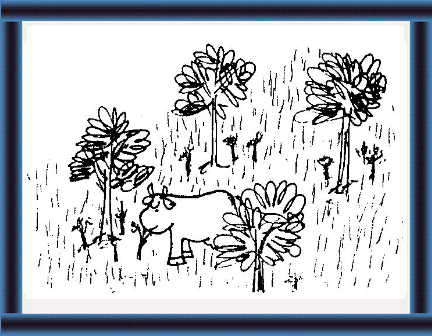 |
|
|
What do you know about pasture and fodder?
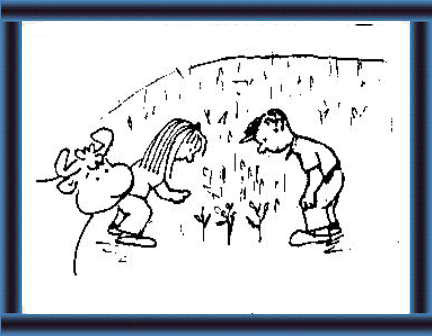 |
1
Why do
your animals need high quality roughages or concentrates? (5-8)
Because they cannot eat enough low value roughages to give good production. |
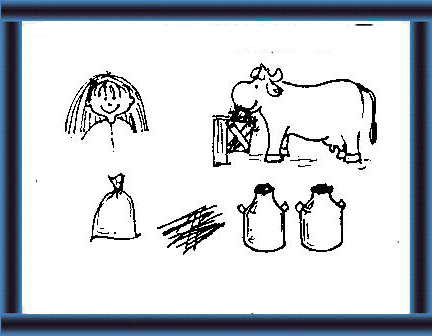 |
2
How can
you select suitable roughages? (9-26)
You must think
about important things e.g.:
|
 |
3
What
improved varieties are there? (27-31)
There are many improved varieties of pastures, legumes, fodders to suit different conditions. |
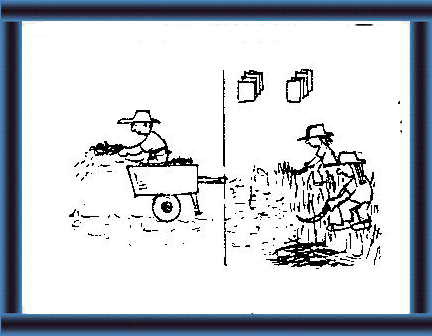 |
4
How can
you manage improved varieties? (32-57)
You must plan
management for:
|
page 57
|
PASTURE AND FODDER Husbandry Unit 5.1: Technical Notes Note: Numbers in brackets refer to illustrations in the Extension Materials. Ruminants including cattle and buffalo have the ability to convert low value roughages such as grass and leaves of trees etc. to high value products such as milk, meat and hides etc. (5) The ability of the animals to produce milk, meat etc. has increased over the years with the implementation of various selection and breeding programmes. But their ability to consume and utilize larger quantities of roughages has not increased in keeping with the increase in productivity. (6) Therefore, animals capable of producing higher quantities of milk and meat have to be supplied with high quality roughages or concentrates, or both. (7) In Asian countries, the roughages available to cattle and buffalo mostly come from crop residues and grasses and weeds etc. growing naturally in forests, roadsides and wasteland not utilized for growing various crops. Where animals with a capacity to produce larger quantities of milk are kept, the shortfall of nutrients available from roughages is met by offering concentrates. The concentrates are mostly crop residues and by-products. In some areas, where income from
dairying (or dairying in combination with meat production/draft) is sufficiently
high, good quality roughages are cultivated for cattle/buffalo feeding,
sometimes as pure stands but mostly as components of an integrated farming
system (see Unit H.1.1). (8)
|
Why do your animals need high quality roughages or concentrates?
 |
5
Dairy cattle and buffalo can change:
- low value roughages e.g. grass, leaves - to high value products e.g. milk, meat. |
 |
6
With
better breeding and selection:
- your animals can produce more but - they cannot eat enough low value roughages for production. |
 |
7 Therefore,
you must give your animals high quality:
- roughages - concentrates - or both. |
 |
8 You should consult your extension worker about growing good quality roughages: - alone - or as part of an integrated farming system (see H 1.1) |
page 59
|
Improved types of roughage There are many improved pasture and fodder varieties that can be grown in Asian countries. However, only a few of them are particularly suitable to the conditions prevailing in any given area, e.g. the climatic conditions such as rainfall, length of dry season, elevation above sea level, soil conditions etc. (Much research has been carried out on the suitability of various species for various conditions. The extension officer should acquire adequate knowledge on the recommended varieties for particular areas, especially with regard to the best establishment and management practices as well as the productivity that can be achieved). In selecting a suitable variety, some important factors to be taken into consideration are nutritive value, growth, persistence, ease of establishment and cost of maintenance. A variety with high nutritive values and good yields may be difficult to establish and costly to maintain. Therefore, the suitability of a particular variety will depend on the particular farmer's circumstances. (9) Nutritive value: The nutritive value of pastures and fodders depends on the amount of energy, proteins, minerals and vitamins that the animals can obtain from them. This in turn depends on how much of the nutrients are contained in the pasture/fodder, how much of the pasture/fodder can be eaten by the animals voluntarily (palatability), how much of what is eaten by the animals can be digested and absorbed, and how much of what is absorbed is wasted e.g. if there are toxic substances, the animals will waste nutrients in overcoming their ill effects. (10-11) Growth: The
yield of dry matter (that part which contains the nutrients) of the pasture
or fodder varies with the variety, under similar soil and climatic conditions.
It is common to find varieties giving yields of 30,000 kg DM per hectare
per year and some hybrid varieties of fodder such as hybrid Napier give
much higher yields under good management, e.g. regular application of fertilizer
and harvesting at appropriate intervals at appropriate height above ground
level. (12)
|
How can you select suitable roughages?
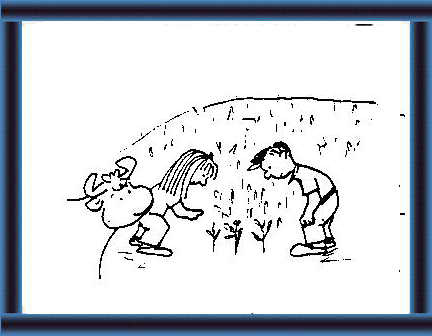 |
9 Your extension
worker can advise you about suitable pasture and fodder crops for your
area.
Many things are important in choosing the right crop for you. |
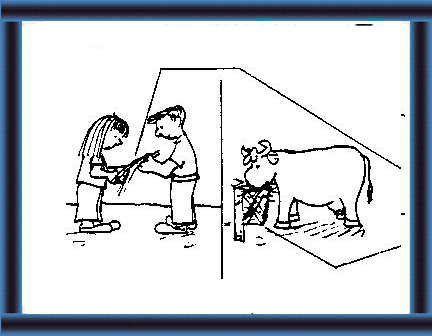 |
Nutritive
value
10
This is how much energy, proteins, minerals and vitamins are:
|
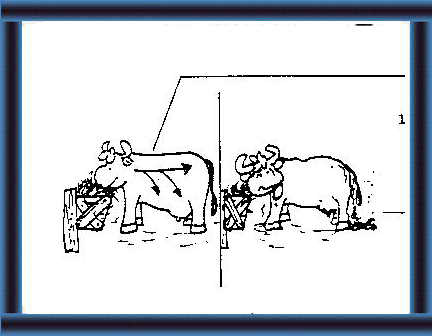 |
11
- in the amount of pasture/fodder your animals can eat and absorb - not wasted because of bad feed causing ill effects. |
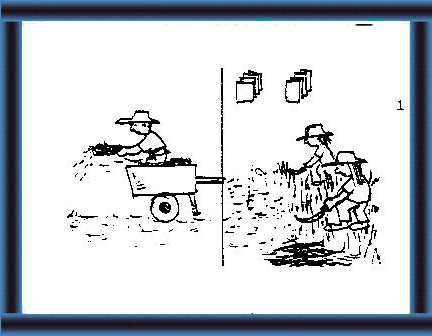 |
Growth
- high yield
of dry matter (which contains nutrients) by e.g. using fertilizer
and
harvesting
at
the right time
|
page 61
|
Even though high annual yields are quite important, it would be advantageous to have this yield distributed over a long period of the year. If the yield is concentrated within a few months, additional expenditure has to be incurred on fodder conservation and there are also corresponding losses of nutrients. (13) Persistence: In Asia, it is common to use a pasture or fodder for several years continuously, once established. This practice reduces the costs of re-establishment. Varieties that continue to produce well, year after year, sometimes even under severe grazing, are said to have a high degree of persistence. These varieties are usually resistant to insects and other diseases and to extreme drought or cold, as the case may be. (14-15) In varieties that spread by runners
or rhizomes the growing points are inaccessible to the grazing animals.
Therefore, they recover quickly even after continuous grazing. (16)
|
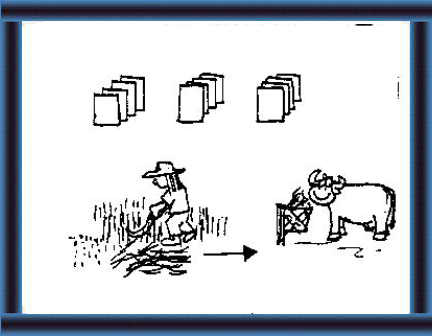 |
13
- the yield over a long period of the year. This reduces the costs of keeping fodder and the loss of nutrients. |
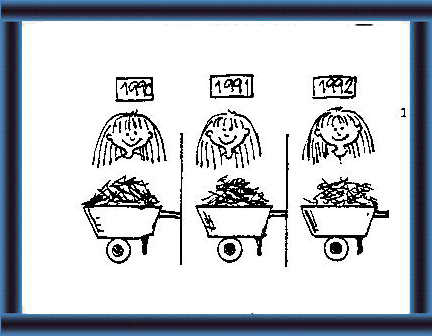 |
Persistence
14 You need a pasture/fodder that produces well for many years, even with heavy grazing. |
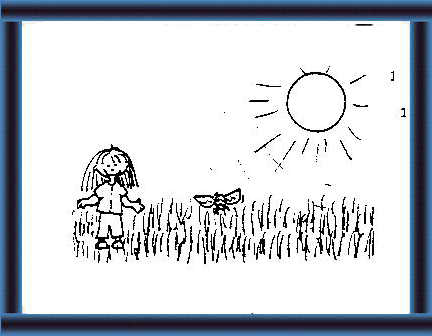 |
This
reduces
the
costs
of
planting a new crop (re-establishment)
15 The pasture/fodder you choose should resist: - insects - disease - drought etc. |
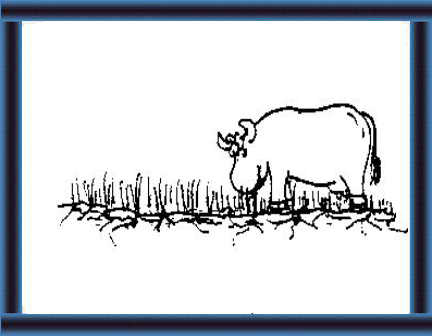 |
16 Your animals
cannot eat crops from runners or rhizomes
because
the growing points are under the ground.
They recover quickly even after continuous grazing.
|
page 63
|
Ease of establishment: Establishment of different varieties is effected through seeds or stem cuttings or root stocks. Different methods of establishment require different types of land preparation. (17) Therefore, in selecting a particular variety of pasture or fodder (or a combination of varieties) the methods of establishment and types of land preparation required and their costs have to be taken into account. (18) Ability to associate (mix) with other crops: There is no single variety of pasture or fodder that can supply the nutrient requirements of dairy cattle and buffalo in a balanced manner. The overall quality can be improved by having a mixture of varieties and also introducing a legume. (19) When pasture/fodder is a component
of an integrated farming system, the ability of the species to survive
in the mixture without causing losses to the other crops in the mixture
is an important aspect. (20)
|
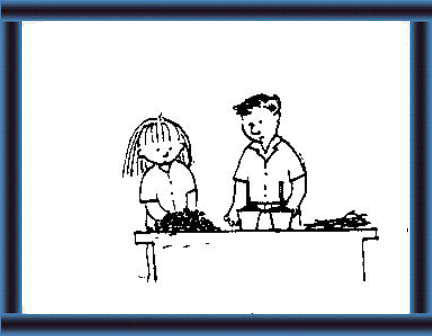 |
Ease of
establishment
17 Land preparation depends upon the pasture/fodder and whether it has seeds, stem cuttings or root stocks. |
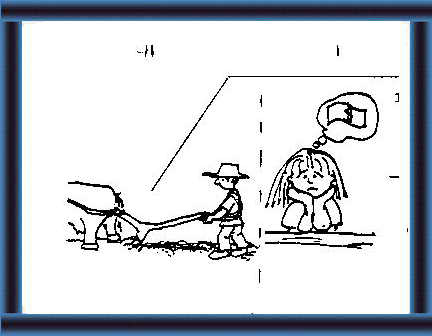 |
18
Before
choosing a pasture/fodder, think about:
- land preparation - costs. |
 |
Ability
to mix with others crops
19 You need different pasture/fodder crops (including a legume) to meet your animals' nutrient requirements. |
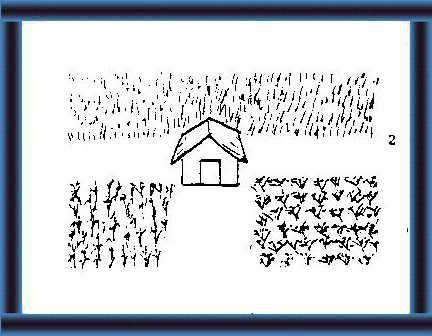 |
20 You must
choose crops which grow together well.
(See H1.1 Integrated Farming Systems)
|
page 65
|
Examples of competition between pasture/fodder and other crops are: - competition for sunlight; reduced sunlight is available for pasture/fodder growing under permanent crops like coconut, rubber etc.; (21) - competition for moisture and fertilizer; pasture/fodder growing together with other crops may compete for moisture and fertilizer unless there is sufficient rainfall and addition of fertilizer to meet the requirements of the crops and the pasture/fodder. (22) Cost of establishment and maintenance: Cost of establishment and maintenance is a very important aspect to be taken into account in making a decision on pasture/fodder establishment. Generally the more nutritious and higher yielding varieties are more costly to establish and maintain, and require higher management skills. (23) However, when land is scarce and
expensive, returns from dairying are sufficiently high, and suitable
varieties are available to meet the local agro-ecological (environmental)
conditions, it may be more profitable to use more nutritious and higher
yielding varieties. (24)
|
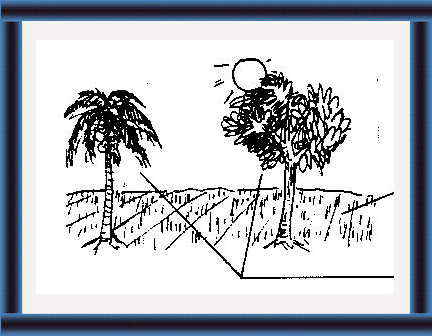 |
Be careful,
some crops compete:
21
|
 |
22
- for moisture and fertilizer, unless there is enough rainfall and you add fertilizer. |
 |
Cost of
establishment and maintenance
23
You must balance:
|
 |
against
24
|
page 67
|
Other benefits: Apart from serving as a feed resource, especially for cattle and buffalo, there are other benefits from pasture/fodder. These include: - building up soil fertility in lands that have been used continuously for crop production over a number of years ("ley" farming technique); (25) - addition of fertility to the soil by incorporation of legumes together with pasture/fodder; - prevention of soil erosion. (26) Among the improved pasture varieties are: Brachiaria brizantha (Signal grass); Brachiaria decumbens; Brachiaria milliformis; Brachiaria mutica (Para grass, Water grass), Brachiaria ruziziensis (Ruzi grass); Cenchrus ciliaris (Buffel grass); Cynodon species; Dactylis glomerata (cocksfoot); Digitaria decumbens (Pangola grass); Panicum maximum (Guinea grass); Panicum maximum (Hamil grass); Paspalum plicatulum; Paspalum urvillei; Pennisetum clandestinum; (Kikuya grass); Setaria sphacelata; Tripsacum laxum (Gautamala grass) etc. The different varieties are more suitable for certain particular conditions. Some examples are: - Brachiaria brizantha for conditions; - Brachiaria milliformis for conditions such as found under coconut; (27) - Brachiaria mutica for conditions; - Brachiaria
ruziziensis, suitable also as a fodder in areas with well drained soil; (28)
|
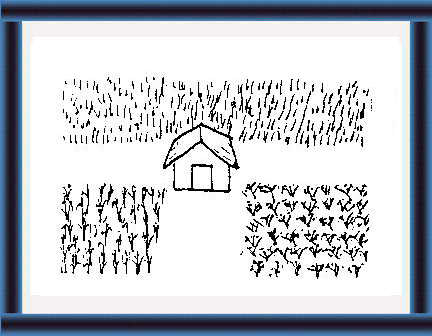 |
Other
benefits
25 These include: - building up soil fertility where you used fields for crop production for many years ("ley" farming technique) |
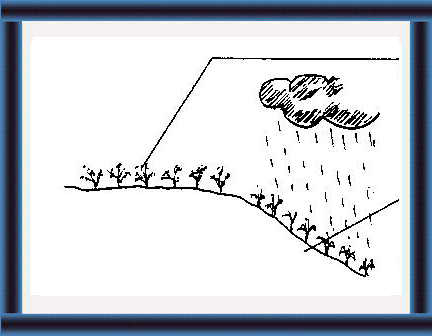 |
26
- increasing fertility by using legumes with pasture/fodder - preventing soil erosion. |
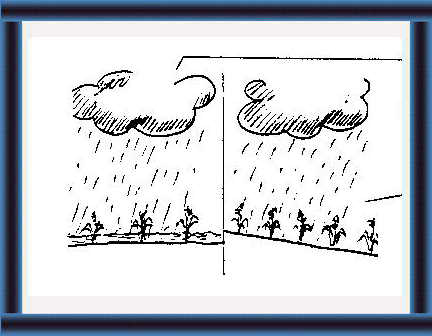 |
28 - Brachiara mutica for water logged conditions - Brachiaria ruziziensis for high rainfall with well-drained soil |
page 69
|
- Pennisetum clandestinum and Paspalum varieties for cool climates in areas with high altitude and high rainfall. (29) Improved legume varieties Among the improved legume varieties are: Centrosema pubescens; Desmodium intortum (Green leaf desmodium); Desmodium uncinatum (Silver leaf desmodium); Dolichos axillaris; Dolichos lab lab (lab lab bean); Gliricidia maculata; Glicine javanica; Glicine wightii; Leucaena leucocephala (ipil-ipil); Phaseolus atropurpureous (Siratro); Pueraria phaseoloides (Tropical Kudzu); Stylosanthes guyanensis (Cook stylo); Stylosanthes hamata; Stylosanthes humilis (Townsville lucerne); Styzolobium atterimum (Velvet bean); Trifolium pratense (Red clover); Trifolium repens (White clover); Trifolium rupellianum (African clover); Trifolium semipilosum (Kenya white clover). The legumes may be established
as pure stands, as components in mixture with other crops as grasses, or
as fences or hedges. (30)
Some of the varieties listed under pastures and legumes can also be used as fodders, e.g. Brachiaria ruziziensis; Panicum varieties; Paspulum varieties; Glyricidia; Leucaena etc. Some varieties that are used mainly
as fodders are, Pennisetum purpureum (Napier
grass or Elephant grass) and its newly developed hybrids such as "NB 21"
or Poosa Giant Napier"; fodder maize varieties and newly developed
hybrids; fodder sorghum varieties and newly developed hybrids etc.
(31)
|
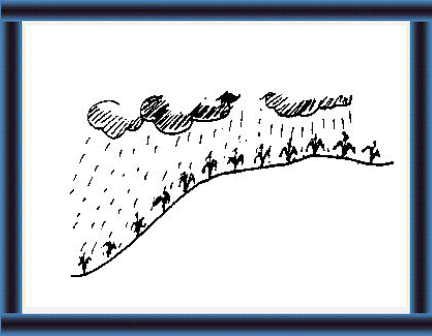 |
29
- Pennisetum clandestinum and Paspalum varieties for cool climates, high altitudes and high rainfalls. |
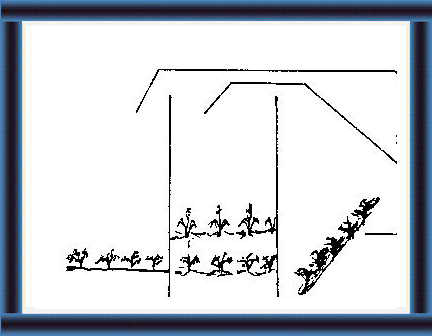 |
Legumes
30 You can grow legumes: - alone - with other crops - as fences or hedges. |
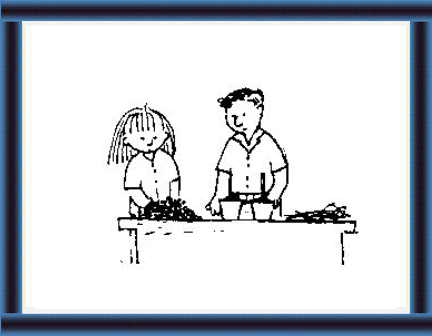 |
Fodder
31
You can also use some varieties of pastures and legumes as fodders e.g.:
|
page 71
|
Land preparation The conventional land preparation methods consist of ploughing the land to break up and loosen the soil, followed by harrowing to further loosen the soil clods into smaller soil particles and for thorough incorporation of the plant materials into the soil. The number of ploughings and harrowings will depend on the soil condition and the type and density of the weeds present at the time of ploughing. (32-33) Generally, species with small seeds require a finer soil than those with large seeds. The species propagated by rootstocks, stem cuttings or stolons may be planted immediately after ploughing on rougher soil surfaces. (34) In high rainfall areas, sloping
land especially is not suitable for fine seedbed preparation because of
the possibilities of severe soil erosion. (35)
|
How can you manage improved varieties?
 |
Land preparation |
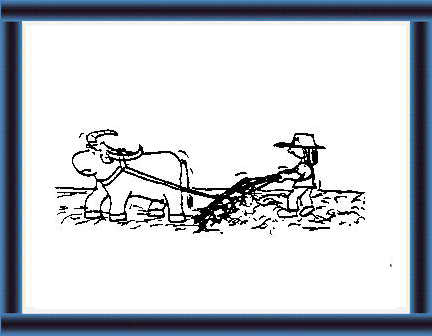 |
33
- harrow to further break up and loosen the soil and mix plant materials with the soil. |
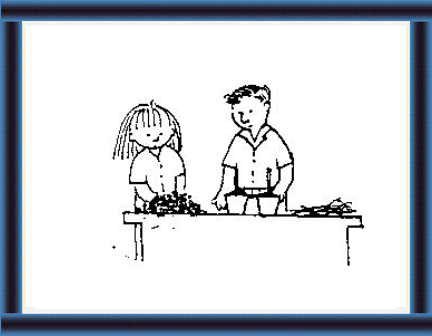 |
34 You can
plant rootstocks, stem cuttings or stolons after ploughing.
Varieties with smaller seeds need finer soil (more harrowing). |
 |
35 In areas with high rainfall and especially sloping land do not make a fine seedbed: - this causes soil erosion. |
page 73
|
Method of planting Methods of planting depend on the planting materials used. When propagation is by seed, one of following methods may be used: - broadcast by hand
Grass seeds need to be embedded at depths varying from 0.75 to 1.25 cm and seeds of big-seeded legumes can be embedded down to 7.5 cm depending on soil moisture. (37) When propagation is by vegetative methods, the follow-ing procedures may be adopted: - stem cuttings (e.g. Napier grass) with 2 or 3 nodes may be planted by hand using a hoe or plant-ing pick, by sticking the stem in an inclined position; (38) - an alternative method is to
lay the stem cuttings in shallow furrows at a suitable depth depending
on soil type and moisture conditions and cover with soil by a plough or
mammoty. (39)
|
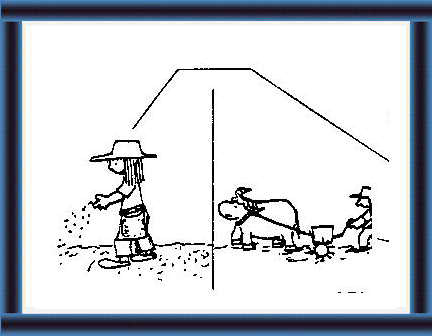 |
Methods
of planting
36
This depends on planting materials:
|
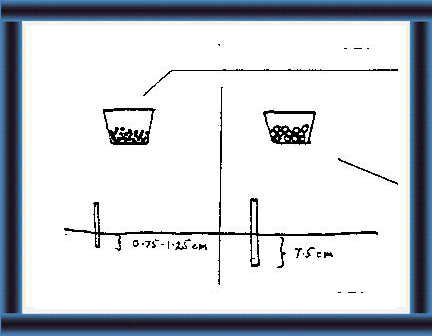 |
37 Place grass:
- seeds at a depth of 0.75 to 1.25 cm - legumes with large seeds at depth up to 7.5 cm depending on soil moisture. |
 |
38
Vegetative
propagation:
Stem cuttings
e.g. Napier grass with 2 or 3 nodes:
|
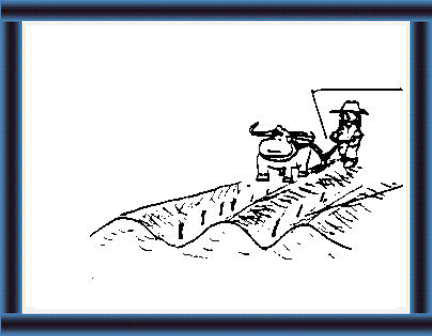 |
39
- lay the stem cutting in shallow furrows - cover with soil by plough or mammoty.
|
page 75
|
- tufts or rootstocks with 3 to 5 tillers (e.g. Guinea grass) may be planted by hand using a hoe at 25 x 25 cm intervals; (40) - an alternative method is to plant in furrows and cover by pushing the soil with the help of the foot. (41) - Pieces of rhizomes or stolons
(e.g. Brachiaria species) may be planted by spreading them on loose seedbed
and pushing into the soil with the foot or by driving a cart or tractor
over them; (42)
- to scatter mature
cuttings on the surface of seedbed and run a disc harrow over them (under
wet conditions); (43)
|
 |
40
Tufts
or rootstocks e.g. Guinea Grass with 3-5 tillers:
- plant with a hoe at 25 x 25 cm spacing or |
 |
41
- plant in furrows and cover by pushing the soil by foot. |
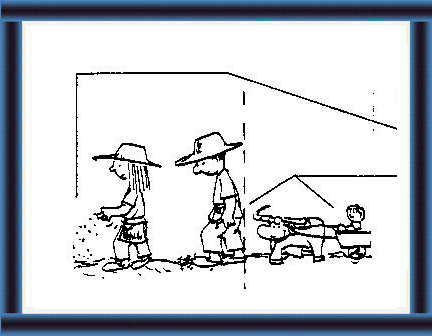 |
42
Rhizome
or stolon pieces e.g. Brachiaria species:
- spread on a loose seedbed - push into the soil by foot or by driving a cart over them or |
 |
43 in wet
conditions:
- spread mature cuttings on a seedbed - run a disc harrow over them
|
page 77
|
- to plant with a hoe or to drop into shallow furrows (44) - and cover by turning soil with the plough or by pushing soil with the foot (under drier conditions - anticipating rain). (45) Time of planting After land preparation, planting should be undertaken without delay to minimize the growth of weeds. Therefore, land preparation should take place with the first rains. At the time of planting, the soil should be moist and additional rainfall should be available for a number of weeks after plant-ing. If irrigation facilities are available, timing of planting would not be constrained by rainfall. (46) An adequate supply of appropriate
planting material of good quality should be ensured at the time of land
preparation. (47)
|
 |
44 in
drier conditions when you expect rain:
- plant with a hoe or drop into shallows furrows |
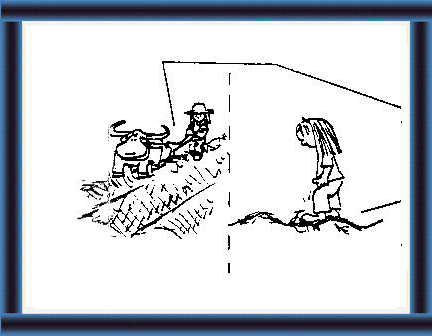 |
45
- turn soil with a plough or push with foot. |
 |
Time of
planting
46 Time land preparation with the first rains so that soil is moist and there is rain after planting (unless you have irrigation). |
 |
47
Make
sure you have enough good quality planting material at the time of
planting.
|
page 79
|
Fertilizer application When the soils are too acidic, it is customary to add Lime or Dolomite to bring the soil pH to the desired levels, before planting the pastures/fodders/legumes. (48) Three primary nutrient elements required by plants are Nitrogen, Phosphorus and Potassium. - Small amounts of Nitrogen, usually applied in the form of Ammonium Sulphate or Urea will help the initial establishment and growth of newly sown or planted grasses. (49) - Application of Phosphorus (usually in the form of Superphosphate) will benefit specially the legumes planted as pure stands or as mixtures with grasses. (50) - Potassium is also needed especially
by legumes for proper establishment. This is usually supplied in
the form of Potassium Chloride. (51)
|
Fertilizer application
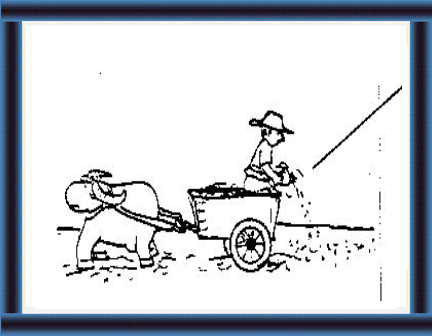 |
48 If your soil is too acid apply Lime or Dolomite before planting pastures/fodders/legumes to bring soil to the correct pH. |
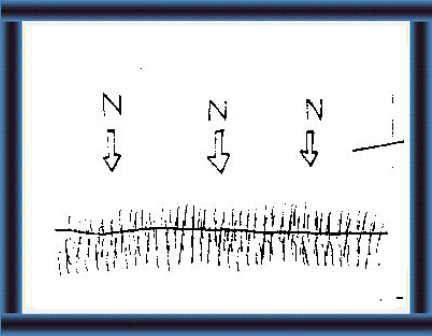 |
49 Plants
need 3 major nutrients.
Give Nitrogen by applying e.g. Ammonium Sulphate or Urea. This helps establishment and growth of grasses. |
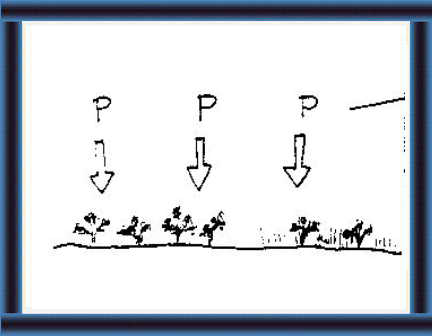 |
50 Give Phosphorus
by applying e.g. Superphosphate.
This helps especially legumes planted alone or with grasses. |
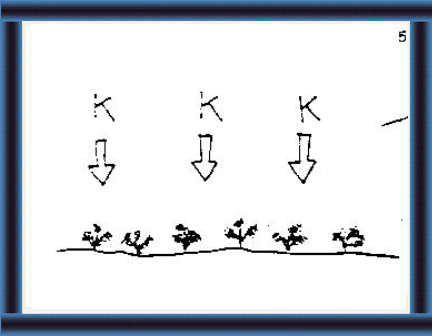 |
51 Give Potassium
by applying e.g. Potassium Chloride.
This helps especially establishment of legumes.
|
page 81
|
These nutrients can also be supplied by adding compost manure which will in addition improve the soil texture (see Unit H.1.2). (52) The quantities of fertilizers to be added and the timing of application will depend on the rainfall, soil fertility and the varieties of pastures, fodders and legumes. The recommendations made by research institutions and extension officers should be followed in this regard. (53) Grazing/cutting of newly planted pastures/fodders The varieties propagated by vegetative methods can be first utilized within 2-3 months, if adequate moisture (rainfall or irrigation) is available. (54) Seeded varieties require a longer
time to become established and may be first used in about 5-6 months time.
(55)
|
 |
52 You can add these nutrients by applying compost manure (See H 1.2). |
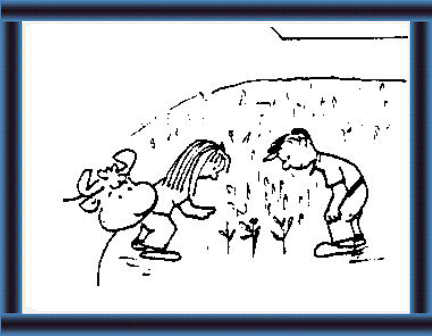 |
53
How
much fertilizer and when you apply depend on:
- rainfall - soil fertility - type of pasture/fodder. Consult your extension worker. |
 |
Grazing/cutting
newly planted pasture/fodder
Vegetative propagation (See 38 above) 54 You can use within 2-3 months if you have enough water (rainfall or irrigation). |
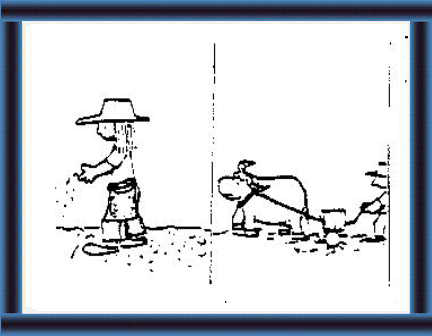 |
Seed propagation
(See 36 above)
55 Establishment takes longer and you can use within 3-6 months.
|
page 83
|
Subsequent management The rate of growth of the pastures/fodders/legumes depend on the varieties used, rainfall (or irrigation), fertility of soil, cutting or grazing intervals etc. (56) As the grasses mature, the dry
matter yield increases but the overall digestibility and crude protein
content decrease. Therefore, for animals to obtain the maximum amount
of nutrients, the grasses have to be grazed or cut before they are too
mature. Different varieties have different optimum grazing/cutting
intervals. Advice should be obtained from research institutions and
extension officers in this regard. (57)
|
Subsequent management
 |
56
Growth of pastures/fodders/legumes depends on:
- variety - rainfall or irrigation - soil fertility - cutting/grazing interval etc. |
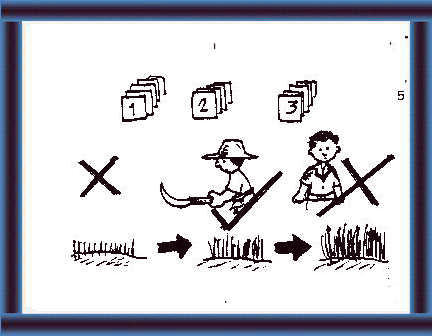 |
57 Older grass
has:
- more dry matter - less digestibility and crude protein content. Consult your extension worker about the best times to graze/cut. |
page 85
|
|
page 88